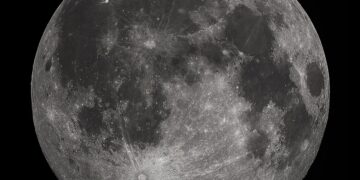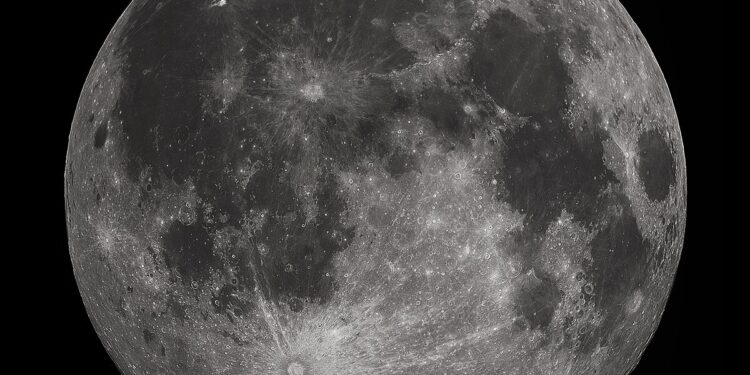For decades, the Moon was believed to be a geologically dead world, a relic from the past, frozen in time after its volcanic activity ceased billions of years ago. Scientists thought that the large maria—dark, flat basaltic plains on the Moon—formed due to volcanic activity early in its history and had remained unchanged ever since.
New Discovery: Small Ridges on the Moon’s Far Side
The Search for Geological Features
Scientists have long studied the Moon’s surface to piece together its history. The Moon’s large, arching ridges on the near side were thought to have formed due to the shrinking of the Moon’s interior, a process called global contraction. These formations, known as lobate scarps, were believed to have been created billions of years ago when the Moon was still cooling and contracting.
However, a team of researchers from the Smithsonian Institution and the University of Maryland used advanced mapping techniques to analyze lunar surface data. They discovered 266 small ridges on the Moon’s far side, areas that had not been studied as extensively as the near side.
Younger Than Expected
The ridges were found in volcanic regions that formed about 3.2 to 3.6 billion years ago, but scientists used crater counting techniques to estimate the age of these small ridges. The technique works like this: the more impact craters a surface has, the older it is. If a ridge cuts through a crater, it must be younger than that crater.
After counting the surrounding craters, scientists estimated that some of these ridges are only 200 million years old or even younger. In geological terms, that’s very recent. Some could even be forming right now, meaning that the Moon’s crust is still shifting today.
The Moon is Shrinking and Moving
What’s Causing the Activity?
The discovery of these ridges suggests that the Moon is still experiencing tectonic stress. But why? Scientists believe the activity could be caused by two main factors:
- The Moon is shrinking: The Moon’s interior is still cooling, and as it contracts, the outer crust buckles and forms ridges.
- Gravitational interactions with Earth: The Moon’s orbit around Earth is gradually changing, which could be causing additional stress on its surface.
Interestingly, these ridges on the far side of the Moon are similar to ones found on the near side, indicating that the entire Moon is experiencing these forces. This suggests that tectonic activity is not just a thing of the past—it is still happening.
Moonquakes: A Sign of Activity?
Apollo Missions Detected Quakes
This new discovery ties into a mystery from decades ago—the shallow moonquakes detected by Apollo missions. Seismometers left behind by Apollo 11, 12, 14, 15, and 16 recorded thousands of moonquakes in the 1970s. Some of these quakes were deep, caused by gravitational interactions with Earth, but others were shallow and near the surface, which suggested tectonic movement.
Now, with the discovery of young ridges, scientists think these quakes could be related to ongoing lunar tectonic activity. This means that the Moon is not just passively eroding from meteor impacts—it’s actively changing.
Implications for Future Moon Missions
1. Lunar Bases and Infrastructure
If the Moon is still tectonically active, it could affect future missions. NASA’s Artemis program, which aims to send astronauts back to the Moon in the next few years, is planning to establish permanent lunar bases. But tectonic activity means that some areas may be unstable due to moonquakes or shifting landforms.
To build safe habitats, scientists need to map active regions and avoid unstable areas where surface movement could damage equipment and structures.
2. Better Understanding of Lunar Water
The Moon is believed to have water ice in permanently shadowed regions, especially near the South Pole. If tectonic forces are at play, they could help transport subsurface ice closer to the surface. This would be important for future astronauts who will need to extract and use lunar water for drinking, fuel, and other resources.
3. New Science Goals for Moon Missions
The presence of active ridges could influence the goals of future lunar missions. Upcoming robotic and crewed missions may now target these regions for further investigation, sending rovers and landers to measure seismic activity, temperature changes, and surface shifts over time.
If confirmed, this discovery could reshape our understanding of the Moon’s evolution and influence where we land, build, and explore.
How the Moon’s Activity Compares to Other Planets
Mercury: A Similar Case?
The idea that a small, rocky world can remain tectonically active for billions of years is not new. Mercury, like the Moon, is shrinking as it cools, and it also has surface faults and ridges caused by this contraction. Some scientists believe that Mercury’s fault scarps could still be forming today, much like the ridges now found on the Moon.
Mars: Tectonic Movement Still Possible
Mars has massive canyons and rift valleys, such as Valles Marineris, suggesting that tectonic forces shaped its surface. However, Mars lacks the kind of plate tectonics seen on Earth, and its activity has likely slowed over time. Still, some Mars landers have detected marsquakes, showing that it too is not entirely geologically dead.
This means that the Moon, Mercury, and Mars all share some degree of ongoing geological activity, despite their differences.
Conclusion: The Moon is More Active Than We Thought
The detection of young ridges on the far side of the Moon tells us that the Moon is shrinking, shifting, and possibly still experiencing moonquakes today. This is groundbreaking because it suggests that other small planetary bodies in our solar system could also be active—and that geological processes last far longer than we assumed.
Reference:
C. A. Nypaver et al, Recent Tectonic Deformation of the Lunar Farside Mare and South Pole–Aitken Basin, The Planetary Science Journal (2025). DOI: 10.3847/PSJ/ad9eaa



















